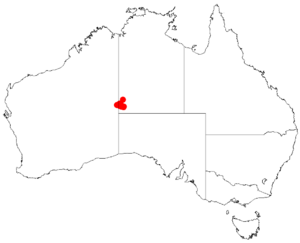Petermann wattle facts for kids
Quick facts for kids Petermann wattle |
|
|---|---|
| Conservation status | |
| Scientific classification | |
| Genus: |
Acacia
|
| Species: |
auricoma
|
 |
|
| Where Petermann Wattle grows in Australia | |
The Petermann wattle (Acacia auricoma) is a type of shrub in the Acacia plant family. It is also known by its Aboriginal names, Alumaru and Nyalpilintji wattle. This plant grows naturally in parts of the Northern Territory and the eastern Goldfields area of Western Australia.
What Does It Look Like?
The Petermann wattle is a shrub that usually grows straight up, reaching about 2.5 meters (8 feet) tall. It doesn't have many branches, and its overall shape can look a bit spread out.
Its young branches are round and covered in soft, velvety hairs. When new shoots appear, they often have a golden color due to these hairs. Like many Acacia plants, the Petermann wattle doesn't have regular leaves. Instead, it has special flattened stems called phyllodes that act like leaves.
These phyllodes stay green all year round. They are hairy and feel a bit leathery. Each phyllode is shaped like an uneven oval and can be from 3 to 10 centimeters (1.2 to 3.9 inches) long. They also have three to five main veins that stand out.
Where Does It Grow?
This wattle is found only in a small, dry area in central Australia. You can see it from places like Anne Range and Bloods Range in the west, stretching to the Petermann Range in the east.
It often grows on rocky slopes made of quartzite, where the soil is very thin. The Petermann wattle is usually part of open shrubland areas, especially where spinifex grasses are common.
How Was It Named?
The Petermann wattle was first officially described by a botanist named Bruce Maslin in 1980. He wrote about it in a scientific paper called Acacia (Leguminosae-Mimosoideae): A contribution to the flora of central Australia.
For a short time in 2003, another botanist, Leslie Pedley, reclassified it under a different name, Racosperma auricomum. However, in 2006, it was moved back to the Acacia group, which is where it remains today.
Images for kids



